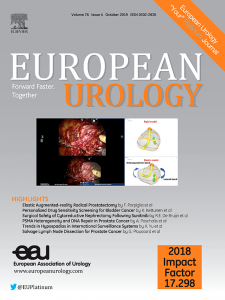Impact of Gene Expression Classifier Testing on Adjuvant Treatment Following Radical Prostatectomy: The G-MINOR Prospective Randomized Cluster-crossover Trial
IF 25.3
1区 医学
Q1 UROLOGY & NEPHROLOGY
引用次数: 0
Abstract
Background and objective
Decipher is a tissue-based genomic classifier (GC) developed and validated in the post–radical prostatectomy (RP) setting as a predictor of metastasis. We conducted a prospective randomized controlled cluster-crossover trial assessing the use of Decipher to determine its impact on adjuvant treatment after RP.
Methods
Eligible patients had undergone RP within 9 mo of enrollment, had pT3–4 disease and/or positive surgical margins, and prostate-specific antigen <0.1 ng/ml. Centers were randomized to a sequence of 3-mo periods of either GC-informed care or usual care (UC). Cancer of the Prostate Risk Assessment Postsurgical (CAPRA-S) recurrence risk scores were provided to treating physicians and patients in all periods.
Key findings and limitations
Impact of GC test results on adjuvant treatment were compared with UC alone. Longitudinal patient-reported urinary and sexual function was assessed. A total of 175 patients were enrolled in 27 periods with GC and 163 in 28 periods with UC. At 18 mo after RP, an average patient in the GC arm received adjuvant treatment 9.7% of the time compared with 8.7% for an average individual in the UC arm (0.99% mean difference, 95% confidence interval [CI] –7.6%, 9.6%, p = 0.8). While controlling for CAPRA-S score, higher GC scores tended to result in an increased likelihood of adjuvant treatment that was not statistically significant (odds ratio [OR] = 1.35 per 0.1 increase in GC score, 95% CI 0.98–1.85, p = 0.066). Using the GC risk groups, reflecting clinical use, a high GC risk was associated with significantly higher odds of receiving adjuvant treatment (OR = 6.9, 95% CI 1.8, 26, p = 0.005) compared with a low GC score, adjusted for CAPRA-S score. There were no differences in patient-reported urinary and sexual function between the study arms. As oncologic outcomes are immature, the present data cannot address whether GC testing provides any cancer control benefit.
Conclusions and clinical implications
GC testing impacts adjuvant therapy administration when viewed through the risk categories presented in the patient report; however, these data do not provide specific support for GC testing in the adjuvant treatment setting.
基因表达分类器测试对前列腺根治术后辅助治疗的影响:G-MINOR 前瞻性随机分组交叉试验
背景和目的Decipher是一种基于组织的基因组分类器(GC),在前列腺根治术(RP)后作为转移的预测指标进行了开发和验证。我们开展了一项前瞻性随机对照分组交叉试验,评估Decipher的使用情况,以确定其对RP术后辅助治疗的影响。方法符合条件的患者在入组9个月内接受了RP术,患有pT3-4疾病和/或手术切缘阳性,前列腺特异性抗原为0.1纳克/毫升。各中心被随机分配到为期3个月的GC知情护理或常规护理(UC)中。在所有时间段内,均向主治医生和患者提供前列腺癌术后风险评估(CAPRA-S)复发风险评分。主要发现和局限性GC检测结果对辅助治疗的影响与单纯UC进行了比较。对患者报告的泌尿和性功能进行了纵向评估。共有 175 名患者在 27 个疗程中接受了 GC 治疗,163 名患者在 28 个疗程中接受了 UC 治疗。RP术后18个月时,GC治疗组患者接受辅助治疗的平均比例为9.7%,而UC治疗组患者接受辅助治疗的平均比例为8.7%(平均差异为0.99%,95%置信区间[CI] -7.6%,9.6%,P = 0.8)。在控制 CAPRA-S 评分的情况下,GC 评分越高,接受辅助治疗的可能性越大,但无统计学意义(GC 评分每增加 0.1,赔率比 [OR] = 1.35,95% 置信区间 [CI] 0.98-1.85,P = 0.066)。使用反映临床使用情况的 GC 风险组,经 CAPRA-S 评分调整后,与低 GC 评分相比,高 GC 风险与接受辅助治疗的几率明显更高(OR = 6.9,95% CI 1.8,26,p = 0.005)。在患者报告的泌尿功能和性功能方面,研究组之间没有差异。由于肿瘤学结果尚不成熟,因此目前的数据还不能说明 GC 检测是否对癌症控制有任何益处。
本文章由计算机程序翻译,如有差异,请以英文原文为准。
求助全文
约1分钟内获得全文
求助全文
来源期刊

European urology
医学-泌尿学与肾脏学
CiteScore
43.00
自引率
2.60%
发文量
1753
审稿时长
23 days
期刊介绍:
European Urology is a peer-reviewed journal that publishes original articles and reviews on a broad spectrum of urological issues. Covering topics such as oncology, impotence, infertility, pediatrics, lithiasis and endourology, the journal also highlights recent advances in techniques, instrumentation, surgery, and pediatric urology. This comprehensive approach provides readers with an in-depth guide to international developments in urology.
 求助内容:
求助内容: 应助结果提醒方式:
应助结果提醒方式:


